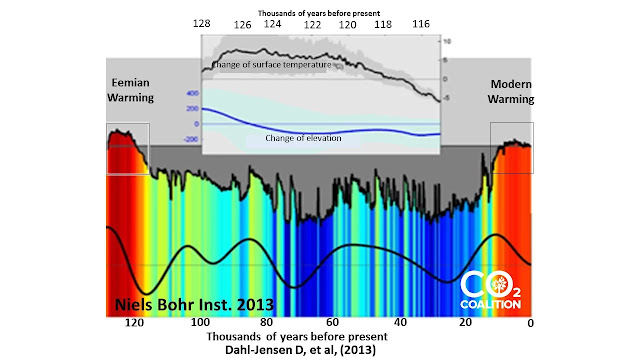Responding to the CO2 Coalition's "Fact #15" on Eemian Warmth
CO2 Coalition's "Fact #15" wants us to believe that temperatures even 8°C warmer than today would be just fine for humanity. In order to make that claim, they need to perform a few tricks. The first trick is to make that 8°C Greenland temperatures instead of global temperatures. The second trick is to redefine "today" as "the mean of the past millennium." Here's how they say it
The results revealed that the Eemian interglacial warm period, between 130,000 and 115,000 years ago, was much warmer than previously thought. In fact, it was, 8°C (14.4°F) warmer than today.
Their source for this is Dahl-Jensen 2013[1], which details the results of the new North Greenland Eemian (NEEM) Ice Drilling ice core. The paper concludes:
NEEM surface temperatures after the onset of the Eemian (126,000 years ago) peaked at 8 ± 4 degrees Celsius above the mean of the past millennium, followed by a gradual cooling that was probably driven by the decreasing summer insolation.So what the paper actually says is that the NEEM site in North Greenland was ~8°C warmer than NEEM was during the mean of the last millennium. That doesn't mean that it was ~8°C warmer than "today," nor does it mean that polar bears and the Greenland Ice Sheet (GrIS) are safe from ~8°C warming today.
CO2 Coalition assures us that "polar bears survived" the Eemian interglacial, since "polar bears evolved about 150,000 years ago and survived the Eemian warm period even though there was seldom any polar ice." But is this true? Genetic models have put the emergence of Polar Bears from Brown Bears between 70,000 and 1.5 million years ago, though the oldest Polar Bear fossil to date was found in the Prince Charles Foreland and dates to between 110,000 and 130,000 years ago. We don't have concrete fossil evidence that there were Polar Bears in the Eemian. However, genetic studies seem to be showing that it's certainly possible (and in fact likely) that Polar Bears emerged from Brown Bears before the onset of the Eemian. All this means is that Polar Bears adapted to living in conditions with low volumes of sea ice, possibly by scavenging the carcasses of whales and other marine mammals, perhaps in much diminished numbers. The comparably slow onset of interglacial conditions would have given them time to adapt. The fact that Polar Bears survived the Eemian is hardly any serious challenge to climate science.
CO2 Coalition also assures us that "Greenland didn't melt," while at the same time saying that a quarter of the GrIS melted. Their words, "the Greenland ice sheet lost only a quarter of its mass. While 25% is significant, it is far less than the predictions of total ice elimination in response to far less warming." Yet where are these predictions of "total ice elimination" with NEEM temperatures ~8°C warmer than the mean of the last millennium? They don't say. But they do say that GrIS lost a quarter of its mass, which is very consistent with the fact that sea levels were 4-8 meters higher during the Eemian. In fact, the paper they cite estimates that the GrIS contributed about 2 m to the observed 4-8 m Eemian sea level maximum. At the NEEM location,
Between 128,000 and 122,000 years ago, the thickness of the northwest Greenland ice sheet decreased by 400 ± 250 metres, reaching surface elevations 122,000 years ago of 130 ± 300 metres lower than the present. Extensive surface melt occurred at the NEEM site during the Eemian, a phenomenon witnessed when melt layers formed again at NEEM during the exceptional heat of July 2012. With additional warming, surface melt might become more common in the future.
In other words, what the CO2 Coalition cite as evidence that "Greenland didn't melt" during the Eemian actually estimates that multiple meters of sea level rise are locked up in the GrIS to be released if we reach temperatures comparable to the Eemian again. With other sources included, we can expect 4-8 m of SLR if we go back to Eemian temperatures. It also should be obvious that the NEEM area was not ~8°C warmer than "today." Global temperatures have increased by ~1°C above the mean of the last millennium, and the Arctic has been warming nearly four times as fast as the global average since 1980.
 |
| Arctic vs Global Warming |
In other words, the Arctic has warmed by about 3°C since 1980, meaning we're already knocking on the door of the lower bound estimate of 8 ± 4°C (a range of 4°C to 12°C), which may explain why melt layers at NEEM are beginning to form again, as mentioned in the abstract of this paper. Global warming is expected to continue to at least 2°C even under the most aggressive mitigation scenarios, and so the Arctic very well might end up well within the range of temperatures described in this paper for the Eemian during the 21st century. Since GHG-caused warming is essentially long-term warming, that means on time scales of hundreds to thousands of years, 4-8 m of sea level rise from AGW is very plausible, given the findings of the paper CO2 Coalition uses to support their claims.
References:




Comments
Post a Comment